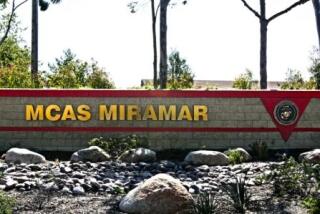Navy Workhorse Is Stabled
- Share via
They served as state-of-the-art fighter jets in Vietnam, as reliable workhorses in the 1991 Persian Gulf War, and, finally, as target planes over the ocean missile range at Point Mugu. Shortly, they’ll serve as museum pieces and additional scrap for the fleet of mothballed American warplanes baking in the sun at an Arizona airbase.
In its day, the F-4 Phantom II was notable for flying at more than twice the speed of sound and as high as 98,000 feet. But the plane, which last made news in a horrific crash at the 2002 Point Mugu Air Show, is about to be formally divested by the Navy, officials said.
While the maintenance program for the aging aircraft at Point Mugu was beset with problems, an exhaustive Navy study concluded that human error caused the 2002 crash of a QF-4, so named because the “Q” denotes a target plane. However, the deaths of the plane’s pilot and navigator before a stunned crowd of thousands had nothing to do with the Navy’s decision to scrap its 20 remaining F-4s, said Doris G. Lance, a Navy spokeswoman.
“The planes are 35 years old and weapons systems have gotten a lot more sophisticated,” Lance said. “They were put on the divestiture list several years ago.”
No date has been set for the final flight of a Navy F-4, but the last of them could be bound for a military museum or the mothball fleet at David-Monthan Air Force Base outside Tucson within a year, Lance said.
When they go, efforts will be made to retrain about 28 civilian employees who now work on them.
The F-4 was a piece of machinery that many veterans came to view with a certain amount of affection. Fast and maneuverable, it was the only plane since World War II to be used by separate branches of the military.
Manufactured from 1959 to 1978, it was derided as “a brick with two engines” for its short, squat appearance -- but what it lacked in looks it made up for in responsiveness.
“It was a very honest airplane,” said Chuck DeBellevue, a former Air Force navigator and pilot who flew 220 combat missions in F-4s over Vietnam. “If you listened to what it could tell you, you could make it do whatever you wanted it to do. If not, it was pretty deadly.”
DeBellevue now works for Del-Jen Services Group, a company based in Rolling Hills Estates that contracts for various management functions on military bases. In Vietnam, he was a top ace, participating in the downing of at least five enemy aircraft. He said the F-4 was a key to his record.
“Some planes would take a hit and catastrophically fail,” he said. “This one would just burn, so if you could stay with it until it was out of the target area, you could be OK. I was very comfortable in it; I knew it would get me home.”
That kind of durability -- the F-4 also was nicknamed “the rhino” -- helped extend its career beyond the point when it was replaced by even faster, more nimble aircraft. For years, it has been used as a target during weapons tests by both the Navy and the Air Force.
At Point Mugu, the planes are flown both as manned vehicles and as “drones” -- unmanned jets electronically guided through aerial contortions by Navy technicians on San Nicolas Island, 60 miles off the coast. Missiles are aimed toward the elusive planes but generally are not meant to hit them, Lance said. Instead, if they come within a certain distance, the test is considered successful, she said.
The aircraft also are used as chase planes to shoot down missiles that veer too far off course, she said. After they’re removed, they will probably be replaced by newer F-14s.
The planes still are actively used by the armed forces of Egypt, Germany, Greece, Israel, Japan, South Korea, Spain and Turkey.
In the U.S., veterans get together for F-4 Phantom conventions and flock to air shows for another glimpse of one aloft.
“There’s a very special feeling to it,” said Bob Collings, whose Massachusetts-based Collings Foundation has the only civilian-owned F-4 in the United States.
“It’s not sleek or graceful,” said Collings, who rents out his plane and others for air shows. “It looks like it should be flying backward. But it was very rugged, and it got the job done.”
More to Read
Sign up for Essential California
The most important California stories and recommendations in your inbox every morning.
You may occasionally receive promotional content from the Los Angeles Times.














